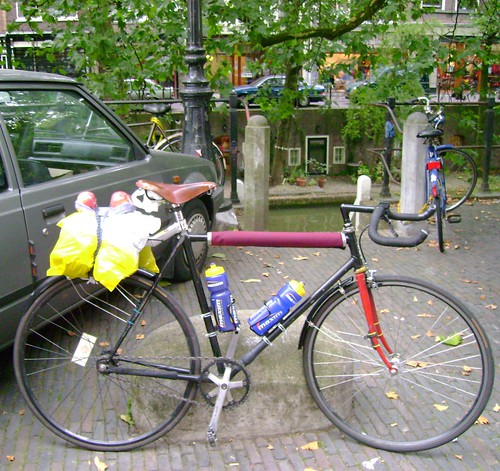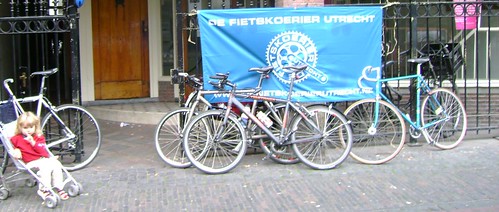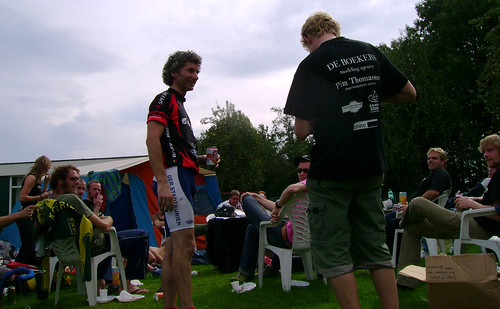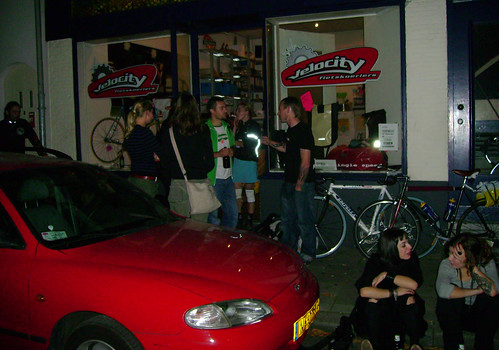A few excerpts from his latest inventions:
Since Jessie and I have a massive pile of broken electronics downstairs (over 10 CRT monitors, a couple LCDs, some TVs, several desktops and laptops, stereos, DVD players, record players, receivers, etc etc) I figured I'd just take a gutted desktop computer and remove some more of the framework inside and make it into a box. It even has a lid that can open and close really easily (and will be waterproof once I cover up the holes in the end with some tin and silicone).
I know I need a light to be safe at night, so I took some old neon wire (pretty cool stuff, just white neon wire with a red cover, less than 1/8" thick) and made a light on the back face of the computer...err, bike box. At least this way everyone will know what I am cruising around at night.
In response to Tom's tinkering, I thought I would detail all the ways I've modified my bike to make it great for cruising around town in all kinds of weather with a week's worth of groceries. While I certainly try DIY as much as possible myself, I also don't mind occasionally buying off-the-shelf stuff, since a large part of the challenge with bicycles is attaching various accessories so they don't get in the way of some other vital component. A loose wire, nut, or something rattling at 20 mph can quickly turn into a spectacular crash, something I've been trying to avoid more and more in the last few years.
The grocery bike is a 1965 Humber Sports. It lived through many winters in Traverse City, Michigan until it made its way to Champaign via Scot McCollum (the friendliest, most knowledgeable bike person you're likely to meet). It was covered in a thin layer of rust, and the rust had eaten through the fender in a few small spots. I sent it to get sandblasted and powdercoated at Coating Specialties. It came back rust free, beautifully (and durably) coated, ready to be built up.
I retapped the bottom bracket shell so it would accept a more modern bottom bracket and I could ditch the old cottered cranks, which aren't unreliable, they just require much more effort to service than newer cotterless cranks. I replaced the wheels (and donated the wheels to others looking for old English three-speed wheels) with a three-speed/drum brake rear and front dynamo/drum brake. Drum brakes are especially useful in adverse weather conditions. When using brakes that engage the rim to stop the bike, rain (plus the road grime it contains) and snow (plus the salt that has been added) gets caught between the brake pad and the rim, quickly eating into the rim until the braking surface is so thin it gives out and the tire and tube pop off the rim. Coaster brakes, drum brakes, disc brakes, and Servo brakes all help to solve this problem.
And if you plan on riding in all that rain and snow, you better have a good mudflap on your front fender. I made this one out of gasket material and put it on with three pop rivets. If you want a little bit better protection, you can make the top a little wider and attach it to the fender struts. The mudflap will curve around the tire a little bit more, keeping the spray coming off the tire more confined.
If you're going to be carrying much, you'll need a rear rack. And while you could put a basket (or computer tower) back there to carry stuff, I prefer to use panniers that hang off the side of the rack. They are waterproof and I can take them into the store with me, so I don't keep accumulating plastic bags. This particular rack (Axiom Odyssey) has the extra guards to keep panniers from getting caught in your wheel and it has one of the highest weight ratings I could find, at around 150 lbs.
And sometimes it's nice to be able to see what you are carrying--in case it is delicate or otherwise in need of a watchful eye--and to have a front rack, also. This one is a CETMA rack from Oregon. I've also mounted the (hub-powered) light underneath the rack, so it doesn't get obstructed by anything I might be carrying. Among other things (plants, trash cans, cardboard boxes, dishes, I've also carried a complete bike on the front rack. I removed the wheels, bungeed the frame on the rack sitting upright, then sandwiched the two wheels on.
You can also see the curtains Rebecca and I made in the upper right side of the photo.
In one last safety feature (besides the front and rear lights), I found these pedals with LEDs in addition to the reflectors. They don't require any batteries, the rotation of the pedals powers the lights, very convenient (similar to these, but mine don't have a capacitor that keeps the LEDs on when you stop).
Any other noteworthy DIY projects and modifications going on out there?




















































